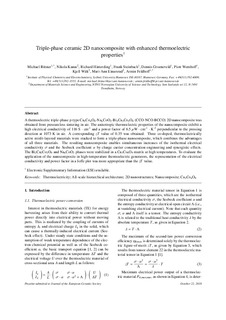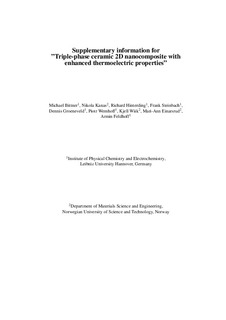| dc.contributor.author | Bittner, Michael | |
| dc.contributor.author | Kanas, Nikola | |
| dc.contributor.author | Hinterding, Richard | |
| dc.contributor.author | Steinbach, Frank | |
| dc.contributor.author | Groeneveld, Dennis | |
| dc.contributor.author | Wemhoff, Piotr | |
| dc.contributor.author | Wiik, Kjell | |
| dc.contributor.author | Einarsrud, Mari-Ann | |
| dc.contributor.author | Feldhoff, Armin | |
| dc.date.accessioned | 2019-03-22T12:17:51Z | |
| dc.date.available | 2019-03-22T12:17:51Z | |
| dc.date.created | 2019-01-16T13:47:33Z | |
| dc.date.issued | 2019 | |
| dc.identifier.citation | Journal of the European Ceramic Society. 2019, 39 1237-81244. | nb_NO |
| dc.identifier.issn | 0955-2219 | |
| dc.identifier.uri | http://hdl.handle.net/11250/2591303 | |
| dc.description.abstract | A thermoelectric triple-phase p-type Ca3Co4O9-NaxCoO2-Bi2Ca2Co2O9 (CCO–NCO–BCCO) 2D nanocomposite was obtained from pressureless sintering in air. The anisotropic thermoelectric properties of the nanocomposite exhibit a high electrical conductivity of 116 S cm−1 and a power factor of 6.5 μW cm−1 K−2 perpendicular to the pressing direction at 1073 K in air. A corresponding zT value of 0.35 was obtained. Three co-doped, thermoelectrically active misfit-layered materials were stacked to form a triple-phase nanocomposite, which combines the advantages of all three materials. The resulting nanocomposite enables simultaneous increases of the isothermal electrical conductivity σ and the Seebeck coefficient α by charge carrier concentration engineering and synergistic effects. The Bi2Ca2Co2O9 and NaxCoO2 phases were stabilized in a Ca3Co4O9 matrix at high temperatures. To evaluate the application of the nanocomposite in high-temperature thermoelectric generators, the representation of the electrical conductivity and power factor in a Ioffe plot was more appropriate than the zT value. | nb_NO |
| dc.language.iso | eng | nb_NO |
| dc.publisher | Elsevier | nb_NO |
| dc.rights | Attribution-NonCommercial-NoDerivatives 4.0 Internasjonal | * |
| dc.rights.uri | http://creativecommons.org/licenses/by-nc-nd/4.0/deed.no | * |
| dc.title | Triple-phase ceramic 2D nanocomposite with enhanced thermoelectric properties | nb_NO |
| dc.type | Journal article | nb_NO |
| dc.type | Peer reviewed | nb_NO |
| dc.description.version | acceptedVersion | nb_NO |
| dc.source.pagenumber | 1237-81244 | nb_NO |
| dc.source.volume | 39 | nb_NO |
| dc.source.journal | Journal of the European Ceramic Society | nb_NO |
| dc.identifier.doi | 10.1016/j.jeurceramsoc.2018.10.023 | |
| dc.identifier.cristin | 1658356 | |
| dc.relation.project | Norges forskningsråd: 228854 | nb_NO |
| dc.description.localcode | © 2018. This is the authors’ accepted and refereed manuscript to the article. Locked until 3.11.2020 due to copyright restrictions. This manuscript version is made available under the CC-BY-NC-ND 4.0 license http://creativecommons.org/licenses/by-nc-nd/4.0/ | nb_NO |
| cristin.unitcode | 194,66,35,0 | |
| cristin.unitname | Institutt for materialteknologi | |
| cristin.ispublished | true | |
| cristin.fulltext | preprint | |
| cristin.qualitycode | 1 | |


